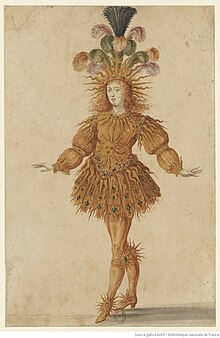Ballet de cour

The ballet de cour ( German court ballet ) is a form of ballet that includes poetry , vocal and instrumental music , choreography and staging and spread from the French court across Europe from the end of the 16th century .
history
During the Renaissance , the dance gained significant importance in the courts of Italy and from there made its way to France. Katharina von Medici engaged the Italian violinist and dancer Baldassarino de Belgioioso, who called himself Balthasar de Beaujoyeulx in France, for the festivities at her court. During his first engagement in October 1581 he staged a spectacular ballet as a wedding present for Anne de Joyeuse and Marguerite de Vaudémont-Lorraine. It was called Ballet comique de la reine , based on the myth of the sorceress Kirke, and quickly became known throughout Europe.
During the reign of Louis XIII. numerous other ballets were performed, but as a result of the arguments during the Fronde , the ballet de cour fell into oblivion. It then reached a new high under the reign of the Sun King Louis XIV , who used the ballet performances in the Palace of Versailles to display the political power of France and the royal court. The most important poet at this time was Isaac de Benserade . He was a specialist in the writing of Livrets , in which, in addition to song lyrics in rhyming form, information about the plot and the actors could be found. When Louis XIV decided in 1670 to stop supporting the court ballet, he gave the genre the fatal blow, but under Jean-Baptiste Lully two new genres developed in the following years: the opéra-ballet and the rather entertaining comédie -ballet .
The structure of a court ballet in the 17th century adhered to the rules of the regular drama , which begins with an exposition , followed by a dramatic intensification , which is resolved by the denouement . At the beginning of the ballet there was an overture in which the theme was presented. This was followed by a few entrées that corresponded to the acts in the theater, with a mixture of dance, singing and declamation. The dances were performed by members of the royal family, courtiers and some professional dancers, who took turns in the individual entrées . For the Grand Ballet as the final highlight, all participants appeared on stage.
Individual evidence
- ↑ Artemis Markessinis: Historia de la danza desde sus Orígenes . Lib Deportivas Esteban Sanz, 1995, pp. 79-81 .
literature
- Artemis Markessinis: Historia de la danza desde sus orígenes . Lib Deportivas Esteban Sanz, 1995. (Google Books)
- Margaret McGowan: L'art du ballet de cour en France (1581-1643) . Paris: CNRS, 1963.